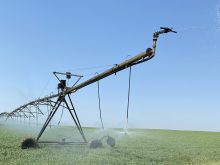Major fertilizer manufacturers lost about one-quarter of their share value last week during a historic stock market collapse that chased speculators from commodity markets.
Egging on the retreat was a report from Merrill Lynch & Co. that cut the ratings of major fertilizer manufacturers because of slumping corn, soybean and wheat prices.
“The near-term fertilizer demand outlook has become more uncertain,” Merrill Lynch analyst Don Carson said in the Oct. 2 report.
Producers are trying to figure out how the stock market carnage might affect the price of one of their most expensive inputs.
Read Also

Rented farmland jumps 3.4 million acres in Saskatchewan and Alberta
Farmland rented or leased in the two provinces went from 25.7 million acres in 2011 to 29.1 million in 2021, says Census of Agriculture data.
“We begin to wonder if (manufacturers) will start discounting fertilizer to keep their volumes up,” said Ian Wishart, president of Keystone Agricultural Producers.
“Coffee shop talk is big on fertilizer prices these days.”
Yen Jong, an analyst with Agrium Inc., one of the leading suppliers of fertilizer in North America, said there is so much turbulence in commodity markets that it is hard to get a handle on things.
But when it comes to figuring out where fertilizer prices are heading it is pretty straightforward – watch what grain prices are doing.
While most agricultural commodity prices have been dropping, many are still above their historical averages. Corn is the key crop to follow because it is North America’s largest crop and a heavy user of many fertilizer products.
Jong said corn prices have fallen to $4.50 to $5 per bushel, down from June’s all-time high of $7.50, but added producers need to remember that a corn farmer’s break-even is $3 per bu., even with today’s higher energy and fertilizer costs.
“There is still incentive there to plant and to apply fertilizer.”
Agrium hasn’t seen reduced demand for fertilizer in the all-important U.S. market. Phosphate inventories are already sold out for the year at the retail level.
Jong can’t understand why Agrium’s share value plummeted 23 percent last week when prices for fertilizer products are double or triple what they were a year ago. Urea and phosphate prices have dropped slightly in the past two weeks, but they remain high, and potash and ammonia prices are strong.
He said fertilizer prices have maintained their value while oil, metals and other commodity values have eroded because of China’s and India’s growing middle class and its penchant for higher protein diets, which means more meat and grain consumption.
“The demand for fertilizer therefore is being maintained because of this tightness in the global grain markets.”
However, Wishart feels fertilizer prices have been too high for too long.
“My gut feel is that there will be downward pressure on the price. Probably not before freeze-up, but after.”
Fertilizer companies encouraged farmers to buy extra product in the summer, believing prices would continue to escalate. As a result, it would reflect poorly on manufacturers if they reduced prices before farmers completed their fall applications.
“If they drop the price now, they’re going to look pretty silly and they’re probably going to have farmers turning up with truckloads of fertilizer saying, ‘you’re taking this back,’ ” Wishart said.
However, he suspects that many farmers will soon regret buying a year-and-a-half supply of high-priced fertilizer products this summer.
Canola is selling at $8.30 per bu., which Wishart said is below the cost of production, forcing farmers to cut back on their input purchases. It’s the same story with other crops, he said.
“What I’m hearing from an awful lot of guys is they’re going to be very, very cautious about how much fall applied fertilizer they put on.”
He doesn’t feel sorry for fertilizer companies in the wake of last week’s share price devaluation. Last summer, KAP called on Ottawa to investigate escalating fertilizer prices. He believes manufacturers are still making exorbitant returns on the backs of farmers.
“They’ve been beyond the normal profit range into the rub-your-hands-together-with-a-gleeful-smile range,” Wishart said.
“I think they’re going to have to roll their profit expectations back into something a little more traditional.”















